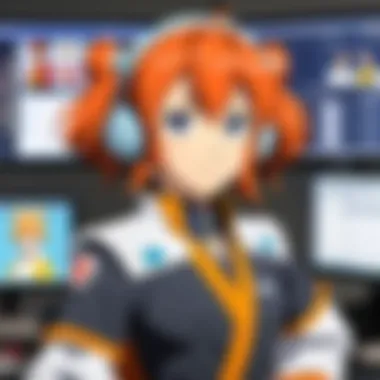Exploring Anime Production Costs: A Financial Overview


Intro
Understanding the complex world of anime production costs is essential for anyone interested in the anime industry. This field involves a diverse range of costs across various genres, influencing not only production teams but also the viewers themselves. A well-crafted anime can evoke strong emotions, yet behind the stunning visuals and compelling stories lies a web of financial investment that shapes the final product.
The financial landscape of anime is not merely about money; it encapsulates the myriad elements from labor expenses to the technology employed, market dynamics, and beyond. In this discussion, we aim to dissect these factors in detail, providing foundation on why certain anime series demand a higher budget compared to others. Through real-life case studies, we shall demonstrate how production values, labor distribution, and creative intricacies play their roles in shaping the viewer's experience. Moreover, these insights are valuable for creators looking to navigate this intricate economy effectively.
Overview of Anime Production Costs
Anime has become a formidable cultural titan over recent decades, captivating audiences not just in Japan but globally. To fully appreciate this phenomenon, one must delve into the financial landscape that fuels anime production. Understanding production costs is not merely an academic exercise; it impacts everything from the quality of animation to the variety of genres that can be offered to viewers.
Definition of Production Costs in Anime
Production costs in anime refer to the total financial resources expended to bring an animated series or film to fruition. This encompasses a variety of factors:
- Staff salaries: The wages paid to directors, animators, writers, and other personnel involved in the creative stages.
- Materials and technology: The costs associated with the software and hardware necessary for creating animation. For instance, the price of licenses for popular animation software like Autodesk Maya or Adobe Animate can be significant.
- Marketing and distribution: Expenses incurred in promoting the finished product and distributing it across various platforms, whether that be on cable networks, streaming services, or physical media.
- Overheads: General operational costs of studios, including utilities, rent, and administrative salaries, which all factor into the overall production budget.
It's not an exaggeration to say that these costs can vary wildly from one project to another. A high-budget series can easily spiral into tens of millions of dollars, whereas smaller, indie productions may operate on shoestring budgets.
The Importance of Understanding These Costs
Grasping the intricacies of anime production costs can illuminate the broader economic dynamics at play within the industry. It allows studios, creators, and even audiences to understand why certain projects flourish while others fade into obscurity. Here are key considerations:
- Investment decisions: Knowledge of costs enables studios to make informed choices regarding which projects to greenlight. High production costs require a compelling business case to ensure a return on investment, so understanding these figures is crucial.
- Quality vs. budget: There’s often a tug-of-war between maintaining high-quality animation and staying within financial limits. Creators must balance artistic vision with fiscal responsibility.
- Genre implications: Different genres demand varied animation styles and techniques, resulting in differing production costs. For example, a high-paced action anime may require more resources than a simple slice-of-life narrative.
"Understanding production costs in anime is like reading the tea leaves; it tells you about the future direction of the industry."
Ensuring that stakeholders understand these complexities not only aids in better project management but also enhances the viewer's appreciation for the craft behind their favorite series.
Factors Influencing Production Costs
When diving into the financial landscape of anime, it’s essential to zero in on the factors that can significantly shape production costs. Understanding these aspects allows creators and investors to navigate the intricacies of the industry more effectively. The costs associated with anime production are not just simple numbers; they reflect the myriad elements that make an anime unique and captivating. Let's dissect these factors to grasp what drives the financial engine behind our favorite animated series.
Staff Salaries and Labor Costs
One of the most prominent components impacting production costs is staff salaries and labor. Hiring talent, from directors and animators to voice actors, can make or break a project financially. Skilled animators, in particular, often demand higher wages given their expertise. For example, when Studio Ghibli produces a film, it invests heavily in talent to ensure high-quality animation. This can lead to costs soaring, often exceeding a few million dollars just for animators’ salaries alone.
Additionally, labor costs don't just include wages but also benefits and working conditions. It’s a reality that good talent tends to stay loyal to studios that offer fair wages and ethical treatment. Thus, studios need to create a working environment that respects and values its artists. This approach could potentially elevate overall production quality, justifying the expenses incurred.
Technological Investments and Tools
In today's anime industry, technological advancements play a crucial role in shaping production costs. The adoption of cutting-edge animation software can come with a hefty price tag. For instance, programs like Toon Boom Harmony or TVPaint can require significant investment. These tools not only streamline the animation process but also enhance the final quality of the work. However, mastering these tools demands training and additional labor costs, complicating the budgetary landscape further.
Moreover, studios must stay updated with the latest technologies to remain competitive. Investing in high-tech solutions, such as rendering farms, can elevate production costs substantially. Despite the upfront expenses, the long-term benefits of increased efficiency and improved quality can outweigh initial outlays.
Marketing and Distribution Expenses


Bringing an anime to life is only half the battle; marketing plays a pivotal role in ensuring its success and visibility. Effective promotional strategies require financial backing to cover trailers, social media campaigns, outreach initiatives, and even merchandise development. A careful allocation of funds to marketing can significantly impact an anime's reception and profitability.
Distribution costs deserve a spotlight too. Once an anime is completed, it has to reach its audience through channels like television, streaming platforms, and even physical media—a varied field, often riddled with negotiation fees and contractual obligations. These costs can escalate quickly, especially when studios choose to market their anime globally.
Licensing and Legal Fees
Licensing is another area that can unexpectedly inflate production costs. Acquiring rights to use particular content, such as music or branded characters, requires upfront payments and ongoing royalties. If you look at popular anime like "Sword Art Online," you'll notice how integrative licensing is to its merchandising and global reach, yet it can come with significant costs.
Alongside licensing, legal fees should not be overlooked. Studios must ensure compliance with regulations and negotiate contracts, which often involve hiring legal experts. All these elements contribute to the financial complexities surrounding anime production and can considerably affect the overall budget.
Exploring these costs helps shed light on the intricate web of financial decision-making that sustains the vibrant world of anime.
Role of Production Studios
The role of production studios in the anime industry is akin to that of a captain steering a ship through treacherous waters. These studios orchestrate the vast complexities involved in anime creation, making them central players in determining production costs and their resulting financial implications. Understanding this role provides valuable insights into how various elements come together, influencing both the quality and the market dynamics of anime projects.
Major Players in the Anime Industry
Within the vast sea of anime production, certain studios stand out due to their influence and achievements. Some of these studio giants include:
- Studio Ghibli: Renowned for its artistic mastery and storytelling depth, Ghibli’s productions typically involve higher budgets due to their meticulous animation process and detailed designs.
- Mappa: Known for its energetic adaptations such as Yuri on Ice and Jujutsu Kaisen, Mappa’s distinct style has made it a leader in the industry, often leading to increased financial backing for ambitious projects.
- Toei Animation: This studio holds a historical significance in anime, producing long-standing franchises like Dragon Ball Z and One Piece. Their extensive experience results in economies of scale that affect production costs.
These studios often dictate not just what stories get told, but how they are portrayed. The blend of artistic vision and business strategy they employ plays a pivotal role in setting production costs that resonate throughout the entire industry.
Comparative Analysis of Studio Budgets
Examining studio budgets offers a fascinating glimpse into how production costs vary widely across the industry. Each studio operates with different financial strategies, leading to diverse output quality and serialization types.
Here’s how several prominent studios stack up:
- High-Budget Productions: Studios like Ufotable, known for Demon Slayer: Kimetsu no Yaiba, pour sizable resources into animation quality. Their budgets can skyrocket to tens of millions, reflecting not only in animation quality but also in sound production and marketing.
- Mid-Level Productions: Companies like A-1 Pictures balance financial viability with quality. They manage to produce engaging series like Sword Art Online on moderate budgets while still ensuring strong visuals.
- Low-Budget Productions: Crunchyroll Originals might operate on a tighter budget for their series, presenting challenges that often necessitate creative adaptations of storytelling and animation to stay afloat in a competitive market.
Understanding these budgetary distinctions allows creators, investors, and fans alike to grasp the implicit financial dance between artistry and profitability in the anime industry.
“In anime, as in life, sometimes you get what you pay for – and knowing where the dollars go can be the difference between a hit and a flop.”
As fans and enthusiasts dive deeper into the world of anime, recognizing these facets will enhance appreciation not just for the stories, but for the intricate financial layers that bring them to life.
Genre-Specific Production Cost Variations
Understanding the genre-specific production cost variations is crucial when dissecting the anime production landscape. Each genre brings its own flavor, attracting diverse audiences and requiring distinct resources. This variety impacts everything from initial investment to marketing strategy. By delving into the financial nuances between different genres, creators and investors gain valuable insight for budgeting and planning.
Shonen vs. Shojo Productions
The difference between Shonen and Shojo genres illustrates how target demographics affect production budgets. Shonen, typically aimed at young male viewers, often demands more action and dynamic animation. This may result in higher costs due to the need for skilled animators and advanced production techniques. For instance, a big name series like My Hero Academia invests heavily in fight choreography that captivates its audience, leading to increased costs in both animation and sound design.


In contrast, Shojo, which tends to appeal to a young female audience, focuses more on character interaction and emotional depth. While these scenes may look simpler on the surface, bringing out the subtleties of romance can also be labor-intensive. A show like Fruits Basket exemplifies how intricate storylines can demand equally intricate artwork and character design, creating a different financial dynamic.
"Understanding the audience's expectations for visual quality and storytelling is worth its weight in gold for getting budgets right."
The Economics of Isakai and Fantasy Genres
Isekai and fantasy genres pose unique challenges and opportunities for production costs. These genres often require elaborate world-building and character designs, especially when depicting alternative realities. The complexity of the animations and detailed artwork can lead to significantly higher budgets. Re:Zero - Starting Life in Another World is one such anime where intricate landscapes and diverse creatures are pivotal, necessitating considerable expenditures.
Moreover, the potential for merchandise associated with these series can offset some costs. Fans often seek out collectibles based on their favorite fantasy worlds, providing an avenue for additional revenue. However, this can also add pressure to deliver high-quality visuals to meet those expectations, affecting the initial investment.
Cost Dynamics in Slice-of-Life and Comedy Series
Contrastingly, slice-of-life and comedy series often maintain a tighter budget, focusing heavily on dialogue and character-driven narratives. Shows like March Comes in Like a Lion may not demand flashy action sequences or intricate animations but prioritize storytelling and voice acting. This often results in lower labor costs as the animation can be less intensive.
However, cutting costs must be done carefully. Though less visually demanding, character animations must still be engaging enough to retain viewer interest. This is a balancing act that, if mishandled, could lead to audiences feeling underwhelmed. In the end, the economics of slice-of-life anime might seem friendlier in theory, but it's still a tightrope walk of balancing charm with budget efficiency.
Case Studies of Notable Anime Projects
Examining notable anime projects offers a gateway into understanding the financial intricacies behind anime production. Case studies shed light on specific instances where financial strategies either succeeded or faltered, providing valuable lessons for creators and stakeholders. This segment illuminates how budgeting choices, production methods, and unique challenges faced in specific projects can significantly impact the overall financial landscape of anime.
Examining High-Budget Productions
High-budget productions are often the glossiest jewels in the anime world, showcasing stunning animation and big-name voice actors. Notable examples include Demon Slayer: Kimetsu no Yaiba and Attack on Titan, both recognized not just for their artistry but also for the substantial financial outlay involved in their creation.
These productions typically involve a plethora of costs:
- Top-tier talent: Getting renowned directors and voice actors can skyrocket expenses.
- Advanced technology: High-quality animation often requires cutting-edge software and hardware.
- Extensive marketing: A hefty budget ensures that the anime reaches its target audience through various promotional channels.
The staggering budget involved in productions, such as Your Name, which was a box office hit with significant return on investment, highlights the risk-reward balance in anime investment. These projects prove that, while costly, a well-executed high-budget anime can yield impressive financial returns and solidify a studio’s reputation.
"Understanding what big-money projects have done right helps smaller creators find their footing in this competitive industry."
Impact of Crowdfunding on Production Costs
Crowdfunding has transformed how anime projects get funded, creating a path for independent creators to bring their stories to life. Platforms like Kickstarter and Campfire have enabled fans to support projects they believe in. For instance, Little Witch Academia gained a positive reception from a short film funded through crowdfunding before it received a full series adaptation. This initial funding allowed the creators to gauge interest and attract further investments.
The benefits of crowdfunding are multifaceted:
- Direct audience engagement: Creators gain a read on their target audience's desires and can tailor their content accordingly.
- Lower initial risk: By securing funds early through community support, creators can offset some financial risks associated with production.
- Community building: Crowdfunding creates a sense of ownership among fans, who become invested in the production and its success.
However, crowdfunding does not come without considerations. Proper budgeting and transparency with backers are crucial. Many projects stress the importance of deliverables; maintaining trust with fans can bolster future crowdfunding efforts.
Through these case studies, it becomes evident that examining the financial strategies of anime projects can provide invaluable insights for anyone looking to navigate the complex world of anime production.
Economic Implications for Creators


In the world of anime, financial decisions ripple through the entire production process, influencing everything from artistic vision to market reach. The economic implications for creators are particularly profound. Understanding how these costs impact their work is vital for achieving both artistic and commercial success.
Balancing Quality and Budget
When creating an animated series, creators often face the daunting task of juggling quality with budget constraints. Striking the right balance can determine not just the success of a project, but its viability as well. High-quality animation tends to command higher costs. The industry has seen a trend where studios are pressured to deliver more polished visuals while keeping a lid on spending.
For instance, a series like Attack on Titan might invest heavily in its animation for impactful scenes, stretching the budget thin but yielding high audience engagement and further merchandise sales. This leads to a cycle where financial investments in quality prompt greater returns, thereby allowing for more extravagant future projects. However, going all in on aesthetics can leave financial plans in shambles if viewership does not meet projections.
- Considerations include:
- Target Audience Expectations: Popular genres, such as shonen or isekai, tend to demand higher production values to satisfy fans.
- Marketing Expenses: Great visuals alone won’t draw crowds; effective marketing campaigns may incur additional costs that must be accounted for.
- Contingency Plans: Budgeting should include a cushion for unexpected costs, as unforeseen challenges are a common hurdle in animation production.
Long-Term Financial Viability
For many creators, the financial landscape isn’t just about the immediate success of a single project. It’s about laying down a foundation for sustained profitability. Long-term financial viability encompasses strategies that focus on ongoing funding, revenue maximization, and audience growth.
A relevant example is the impact of streaming platforms like Crunchyroll and Netflix. These services not only provide upfront funding for projects but also create a new revenue model through subscription-based viewership. As these platforms grow and expand their library, creators can benefit from larger audiences while keeping costs more predictable. Some creators even opt for partnerships with these platforms, allowing them to allocate funds more strategically, ensuring more than just a one-off success.
- Key Factors to Consider in Long-Term Viability:
- Diversifying Revenue Streams: Relying solely on viewership might not be sustainable; merchandise, licensing, and crowdfunding offer additional income avenues.
- Building a Brand: A strong brand presence can greatly enhance a creator’s marketability. Iconic characters or unique storytelling methods can lead to increased royalties through merchandise and spin-off series.
- Adapting to Market Trends: Remaining attuned to what resonates with audiences can allow creators to pivot their projects where necessary.
"In the world of anime production, navigating the financial landscape isn't merely an exercise in accounting; it's an art form in itself, intimately tied to the creator's vision."
Understanding these economic implications equips creators not just to tackle the present, but to build a resilient future in an ever-changing industry.
Future Trends in Anime Production Costs
As we cast our gaze toward the horizon, it becomes increasingly clear that the landscape of anime production costs is shifting. These changes have broad implications, not only for creators but also for audiences who consume anime. Understanding these future trends is paramount for anyone involved in or passionate about the industry.
One of the key aspects to consider is the globalization of anime. As production studios tap into international markets, they are faced with a myriad of economic considerations. Costs can fluctuate based on regional economic conditions, exchange rates, and even local labor laws. The diversity of funding sources also adds complexity to budgeting. For instance, a studio in Japan may now team up with international partners to co-produce series, thereby affecting individual budget lines through shared investments.
Additionally, this merging of global cultures can lead to heavier financial strains when it comes to quality control and localization. Each market has its own expectations and cultural nuances. Studios must allocate resources wisely, making the blend of art and commerce more intricate than ever. The competition on a global stage can drive production costs up or down, creating an unpredictable environment for creators.
"The interconnectedness of financial markets can serve both as a lifeline and a stumbling block for anime studios."
Another trend gaining momentum is the surge of streaming services. Platforms like Crunchyroll, Netflix, and Amazon Prime Video are investing heavily in anime, reshaping how shows are financed and distributed. This influx of capital can initially appear as a golden goose for studios, but it comes with strings attached. These services often seek a specific type of content to appeal to global audiences, which may pressure creators to pivot away from their original artistic visions.
Moreover, the subscription model poses its own challenges. Studios must balance the desire for unique storytelling that resonates with niche audiences against the need to produce hits that attract subscribers. This balancing act can lead to increased production budgets, as studios compete to create the next big sensation that grabs viewer attention.
Impact of Globalization on Costs
In exploring the globalization of anime production costs, several noteworthy factors emerge:
- Variable Exchange Rates: Fluctuations can drastically alter expenses when studios contract internationally.
- Cultural Localization: Tailoring content to various audiences incurs additional costs, which can squeeze budgets.
- Collaborative Projects: International partnerships can lead to shared costs, but also shared risks and complexities in management.
- Market Dynamics: The variability in anime's popularity across regions influences how funds are allocated among projects, impacting overall budgets and resource management.
Understanding the nuances of these elements helps demystify how studios navigate an increasingly complex financial landscape.
Potential Effects of Streaming Services
The rise of streaming services marks another chapter in the evolution of anime production costs, bringing about several pivotal changes:
- Funding Opportunities: Many studios now have access to new funding streams, but the competition to secure these funds is fierce.
- Content Expectations: Streaming platforms may push studios to deliver faster and at a higher quality, often leading to increased budgets.
- Shortened Release Windows: The demand for quick turnarounds can place financial strain on production timelines. Tracks must be made without compromising quality, meaning more staff and resources are needed in less time.
- Promotion and Marketing Strategies: With streaming platforms often handling their own marketing, studios can save on distribution costs but must still produce appealing content that stands out in a crowded market.



